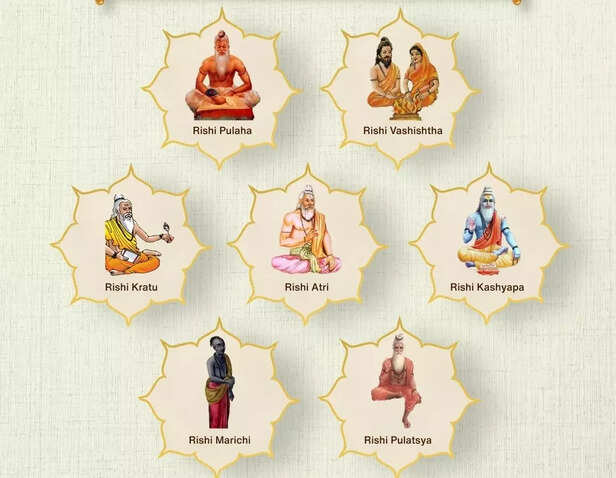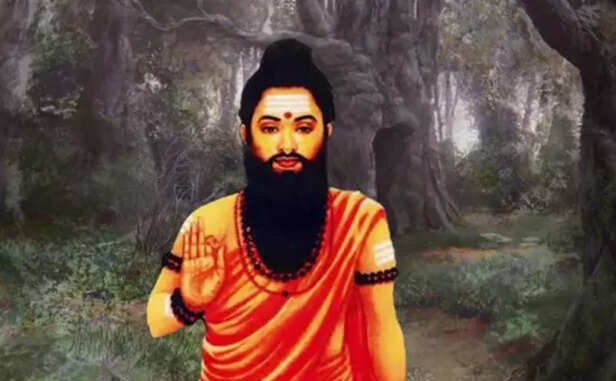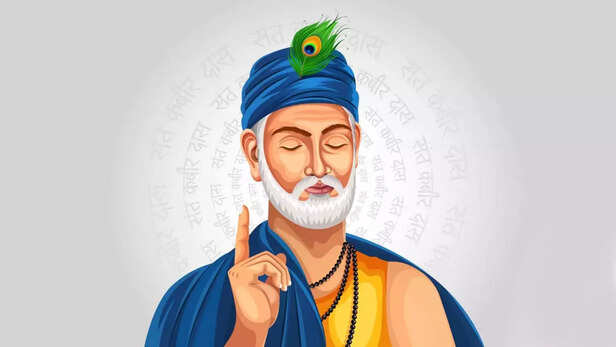Difference Between Rishi, Muni, Sadhu and Sant— Understanding the Pillars of Sanatan
Ankit Gupta | Apr 30, 2025, 14:44 IST
Rishi, Muni, Sadhu, Sanyasi
Rishi, Muni, Sadhu, and Saint — four sacred paths, each reflecting a unique facet of Sanatan spirituality. Discover who sees the truth, who meditates in silence, who renounces the world, and who spreads divine love.
In the rich spiritual tradition of Sanatan Dharma, a wide spectrum of seekers, teachers, and renunciates exist, each playing a unique role in the spiritual evolution of society and self. Among these, the figures of the Rishi, Muni, Sadhu, and Saint hold a revered place. Though often used interchangeably in casual discourse, each of these titles refers to distinct spiritual paths and responsibilities.

The word Rishi comes from the Sanskrit root “ṛṣ”, meaning “to see” or “to know.” A Rishi is not just a scholar or a wise man but a seer of cosmic truths. The Rishis were those who heard (or "saw") the Vedic mantras in deep states of consciousness and passed them on in the form of hymns. These were not composed through logical thinking but revealed in a state of heightened awareness. Rishis like Vasistha, Vishwamitra, and Atri were the original transmitters of divine knowledge, whose insights still form the backbone of Hindu philosophy.
Rishis were often married, led lives with families (Grhastha), and yet attained the highest states of realization. They engaged in yajnas, teaching, and social reform, embodying wisdom, balance, and divine sight.
India has always been a land of sages. The Rishi tradition has a special importance in our society. Even today our society and families are considered to be descendants of some Rishi.
Rishi is a term derived from the Vedic tradition used to refer to people who have mastered the Vedic texts. In other words, it can be said that such a person who studied the Vedic tradition on the strength of his unique concentration and saw unique words, knew their obscure or secret meanings and manifested that knowledge by writing only for the welfare of the living beings are called Rishis.
The Rishis are considered to be enlightened seers of the era. It is believed that by their yogic power, the knowledge of Parmatama (Supreme Soul) is available to them and they are able to see the material as well as the conscious world.
According to the famous Sanskrit synonyms dictionary compiled by Amarsimha, there are seven types of sages, Brahmarishi (they have attained the highest divine knowledge, infinite knowledge/omniscience and self-knowledge), Devarshi, Maharishi, Paramrishi, Kandarshi, Shrutarishi and Rajarshi.
The Trinity have gifted great Rishis with their heavenly bodies over which these Rishi preside. The seven prominent stars in the sky also called Ursa Major or the Great Bear constellation is one such example. These heavenly bodies and their presiding Rishis are called Ketu, Pulah, Pulatsya, Atri, Angira, Vasistha and Bhrigu. Similarly, some other lists exist in which Kautsa, Gautam, Kashyapa, Vishwamitra, Jamadagni, Bhardwaj have also been included as Sapta Rishis.

In contrast, a Muni is a figure of profound silence and introspection. Derived from the word “mauna” (silence), a Muni is one who withdraws from speech and external distractions to dwell in the inner silence of the soul. Munis are often seen as meditative recluses, detached from worldly affairs, deeply immersed in contemplation.
Not all Munis are Rishis, and not all Rishis are Munis. While Rishis actively engage in teaching and revelation, Munis prefer the path of stillness and solitude, walking the inner landscape of consciousness. Think of figures like Lomasha Muni, or Jada Bharata, who lived in apparent simplicity but were deep oceans of inner realization.
Munis were also sages, but they lacked anger and hatred. In the Bhagavad Gita it is said about the sages whose mind is not disturbed by sorrow, who do not desire for happiness and who are free from attachment, fear and anger, such saints with unblemished intelligence are called Munis.
The word Muni is derived from Mauni which means one who does not speak or speaks silently. Such sages who took the oath of silence or spoke very little for a particular period were called Munis. In ancient times, silence has been considered as a sadhana or penance. Many sages used to do this sadhna and used to remain silent. The word Muni is used only for such sages. The word Muni has also been used for some such sages who always used to chant God and meditate on Lord Narayan like Narad Muni (he is considered a top devotee of Lord Narayan and he is created by Lord Brahma).
Munis have also been discussed in Jain texts. The person whose soul is stable by restraint, devoid of worldly desires, having a sense of protection for living beings, non-violence, truth, celibacy, language, purification of food and purification in handling of religious equipment.

A Sadhu is a spiritual practitioner who has renounced worldly life in pursuit of liberation (moksha). The term comes from “sadh,” meaning “to accomplish” or “to strive.” Sadhus are often associated with the path of tapas (austerity), yoga, or bhakti (devotion). They are easily recognizable by their ochre robes, matted hair, and wandering lifestyle.
Unlike Rishis and Munis, who may stay in one place or live in silence, Sadhus are constantly on the move, spreading the energy of detachment and spiritual aspiration. They perform severe penances, chant mantras, and live with minimal needs, often depending on alms. Their presence reminds society of the impermanence of worldly attachments and the necessity of spiritual striving.
Sadhus are not defined by scholarly knowledge or meditative silence but by their burning renunciation and one-pointed spiritual goal.

The term Saint, though Western in tone, finds its spiritual equivalent in India in figures like Sant Kabir, Sant Ravidas, Mata Amritanandamayi, and Sri Ramakrishna. Saints are those rare souls who combine realization with accessible compassion. They often guide ordinary people in simple language, preaching bhakti, love, service, and surrender.
Saints may or may not be renunciates. What defines them is their overflowing divine love, their ability to heal, teach, and uplift people from all walks of life. They are society’s moral compass, not through sermons, but through the example of their lives. Saints often found movements, reform caste divisions, break social taboos, and establish spiritual egalitarianism.
In the spiritual hierarchy, Saints may be more socially active than Rishis, more emotionally expressive than Munis, and more compassionate than Sadhus. They are the messengers of divine grace.
Each of these figures – Rishi, Muni, Sadhu, and Saint – represents a different mode of spiritual realization:
In knowing their distinctions, we do not separate them but better understand the complete path of spiritual evolution.
Rishi – The Seer of Truth

The Saptarishis (Image Credit: Freepik)
The word Rishi comes from the Sanskrit root “ṛṣ”, meaning “to see” or “to know.” A Rishi is not just a scholar or a wise man but a seer of cosmic truths. The Rishis were those who heard (or "saw") the Vedic mantras in deep states of consciousness and passed them on in the form of hymns. These were not composed through logical thinking but revealed in a state of heightened awareness. Rishis like Vasistha, Vishwamitra, and Atri were the original transmitters of divine knowledge, whose insights still form the backbone of Hindu philosophy.
Rishis were often married, led lives with families (Grhastha), and yet attained the highest states of realization. They engaged in yajnas, teaching, and social reform, embodying wisdom, balance, and divine sight.
India has always been a land of sages. The Rishi tradition has a special importance in our society. Even today our society and families are considered to be descendants of some Rishi.
Rishi is a term derived from the Vedic tradition used to refer to people who have mastered the Vedic texts. In other words, it can be said that such a person who studied the Vedic tradition on the strength of his unique concentration and saw unique words, knew their obscure or secret meanings and manifested that knowledge by writing only for the welfare of the living beings are called Rishis.
The Rishis are considered to be enlightened seers of the era. It is believed that by their yogic power, the knowledge of Parmatama (Supreme Soul) is available to them and they are able to see the material as well as the conscious world.
Types of Rishi
The Sapt (Seven) Rishis
Muni – The Silent Meditator

Agatsya Muni
In contrast, a Muni is a figure of profound silence and introspection. Derived from the word “mauna” (silence), a Muni is one who withdraws from speech and external distractions to dwell in the inner silence of the soul. Munis are often seen as meditative recluses, detached from worldly affairs, deeply immersed in contemplation.
Not all Munis are Rishis, and not all Rishis are Munis. While Rishis actively engage in teaching and revelation, Munis prefer the path of stillness and solitude, walking the inner landscape of consciousness. Think of figures like Lomasha Muni, or Jada Bharata, who lived in apparent simplicity but were deep oceans of inner realization.
Munis were also sages, but they lacked anger and hatred. In the Bhagavad Gita it is said about the sages whose mind is not disturbed by sorrow, who do not desire for happiness and who are free from attachment, fear and anger, such saints with unblemished intelligence are called Munis.
The word Muni is derived from Mauni which means one who does not speak or speaks silently. Such sages who took the oath of silence or spoke very little for a particular period were called Munis. In ancient times, silence has been considered as a sadhana or penance. Many sages used to do this sadhna and used to remain silent. The word Muni is used only for such sages. The word Muni has also been used for some such sages who always used to chant God and meditate on Lord Narayan like Narad Muni (he is considered a top devotee of Lord Narayan and he is created by Lord Brahma).
Munis have also been discussed in Jain texts. The person whose soul is stable by restraint, devoid of worldly desires, having a sense of protection for living beings, non-violence, truth, celibacy, language, purification of food and purification in handling of religious equipment.
Sadhu – The Renunciate Seeker

Sadhu (Image Credit: Pixel)
A Sadhu is a spiritual practitioner who has renounced worldly life in pursuit of liberation (moksha). The term comes from “sadh,” meaning “to accomplish” or “to strive.” Sadhus are often associated with the path of tapas (austerity), yoga, or bhakti (devotion). They are easily recognizable by their ochre robes, matted hair, and wandering lifestyle.
Unlike Rishis and Munis, who may stay in one place or live in silence, Sadhus are constantly on the move, spreading the energy of detachment and spiritual aspiration. They perform severe penances, chant mantras, and live with minimal needs, often depending on alms. Their presence reminds society of the impermanence of worldly attachments and the necessity of spiritual striving.
Sadhus are not defined by scholarly knowledge or meditative silence but by their burning renunciation and one-pointed spiritual goal.
Saint – The Path-Shower of Love and Compassion

Sant Kabir ( Image Credit: ET)
The term Saint, though Western in tone, finds its spiritual equivalent in India in figures like Sant Kabir, Sant Ravidas, Mata Amritanandamayi, and Sri Ramakrishna. Saints are those rare souls who combine realization with accessible compassion. They often guide ordinary people in simple language, preaching bhakti, love, service, and surrender.
Saints may or may not be renunciates. What defines them is their overflowing divine love, their ability to heal, teach, and uplift people from all walks of life. They are society’s moral compass, not through sermons, but through the example of their lives. Saints often found movements, reform caste divisions, break social taboos, and establish spiritual egalitarianism.
In the spiritual hierarchy, Saints may be more socially active than Rishis, more emotionally expressive than Munis, and more compassionate than Sadhus. They are the messengers of divine grace.
Four Faces of the Eternal Seeker
- The Rishi sees and speaks divine knowledge.
- The Muni sinks into silence and self-absorption.
- The Sadhu renounces and strives.
- The Saint loves and leads.
In knowing their distinctions, we do not separate them but better understand the complete path of spiritual evolution.
